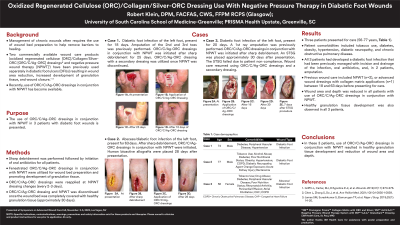Case Series/Study
(CS-083) Oxidized Regenerated Cellulose (ORC)-Collagen-Silver-ORC Dressing use with Negative Pressure Wound Therapy in Diabetic Foot Wounds

Introduction: Management of chronic wounds often requires the use of wound bed preparation to help remove barriers to healing. Two commercially available wound care products (oxidized regenerated cellulose [ORC]/Collagen/Silver-ORC [ORC/C/Ag-ORC] dressings* and negative pressure wound therapy [NPWT]†) have been previously used separately in diabetic foot ulcers resulting in wound area reduction, increased development of granulation tissue, and wound closure.1-3 Recently, use of ORC/C/Ag-ORC dressings with NPWT has become available. The use of ORC/C/Ag-ORC dressings with NPWT in 3 patients with diabetic foot wounds is presented.
Methods: Sharp debridement was performed followed by initiation of oral antibiotics for all patients. Fenestrated ORC/C/Ag-ORC dressings with NPWT were utilized for wound bed preparation and promoting development of granulation tissue. ORC/C/Ag-ORC was reapplied at NPWT dressing changes, every 2-3 days. ORC/C/Ag-ORC dressings with NPWT were discontinued once the wound bed was completely covered with healthy granulation tissue (approximately 30 days).
Results: Three patients presented for care (age range 56-77 years). Patient comorbidities included tobacco use, diabetes, obesity, hypertension, diabetic neuropathy, and chronic obstructive pulmonary disease. All 3 patients developed a diabetic foot infection that had been previously managed with incision and drainage of the infection, oral antibiotics, and, in 2 patients, amputation. Previous treatment included NPWT (n=2) or advanced wound dressings with collagen matrix applications (n=1) between 18 and 63 days before presentation to the wound care clinic. Wound area and depth were reduced in all patients with use of ORC/C/Ag-ORC dressings and NPWT. Healthy granulation tissue development was also observed in all 3 patients. All wounds were closed using either split-thickness skin grafts (STSG) or by secondary intention.
Discussion: In these 3 patients, use of ORC/C/Ag-ORC dressings with NPWT resulted in healthy granulation tissue development and reduction of wound area and depth allowing for successful wound closure with STSG or by secondary intention.
Trademarked Items: *3M™ Promogran Prisma™ Collagen Matrix with ORC and Silver, †3M™ ActiV.A.C.™ Negative Pressure Wound Therapy System (3M Health Care, St. Paul, MN)
References: 1. Griffin L, Carter MJ, D'Agostino R, Jr., D'Agostino McGowan L. Comparative Effectiveness of Two Collagen-containing Dressings: Oxidized Regenerated Cellulose (ORC)/Collagen/Silver-ORC Dressing Versus Ovine Collagen Extracellular Matrix. Wounds. 2019;31(11):E73-E76.
2. Chen L, Zhang S, Da J, et al. A systematic review and meta-analysis of efficacy and safety of negative pressure wound therapy in the treatment of diabetic foot ulcer. Annals of palliative medicine. 2021;10(10):10830-10839. doi:10.21037/apm-21-2476
3. James SM, Sureshkumar S, Elamurugan TP, Debasis N, Vijayakumar C, Palanivel C. Comparison of Vacuum-Assisted Closure Therapy and Conventional Dressing on Wound Healing in Patients with Diabetic Foot Ulcer: A Randomized Controlled Trial. Nigerian Journal of Surgery. 2019;25(1):14-20. doi:10.4103/njs.NJS_14_18
Methods: Sharp debridement was performed followed by initiation of oral antibiotics for all patients. Fenestrated ORC/C/Ag-ORC dressings with NPWT were utilized for wound bed preparation and promoting development of granulation tissue. ORC/C/Ag-ORC was reapplied at NPWT dressing changes, every 2-3 days. ORC/C/Ag-ORC dressings with NPWT were discontinued once the wound bed was completely covered with healthy granulation tissue (approximately 30 days).
Results: Three patients presented for care (age range 56-77 years). Patient comorbidities included tobacco use, diabetes, obesity, hypertension, diabetic neuropathy, and chronic obstructive pulmonary disease. All 3 patients developed a diabetic foot infection that had been previously managed with incision and drainage of the infection, oral antibiotics, and, in 2 patients, amputation. Previous treatment included NPWT (n=2) or advanced wound dressings with collagen matrix applications (n=1) between 18 and 63 days before presentation to the wound care clinic. Wound area and depth were reduced in all patients with use of ORC/C/Ag-ORC dressings and NPWT. Healthy granulation tissue development was also observed in all 3 patients. All wounds were closed using either split-thickness skin grafts (STSG) or by secondary intention.
Discussion: In these 3 patients, use of ORC/C/Ag-ORC dressings with NPWT resulted in healthy granulation tissue development and reduction of wound area and depth allowing for successful wound closure with STSG or by secondary intention.
Trademarked Items: *3M™ Promogran Prisma™ Collagen Matrix with ORC and Silver, †3M™ ActiV.A.C.™ Negative Pressure Wound Therapy System (3M Health Care, St. Paul, MN)
References: 1. Griffin L, Carter MJ, D'Agostino R, Jr., D'Agostino McGowan L. Comparative Effectiveness of Two Collagen-containing Dressings: Oxidized Regenerated Cellulose (ORC)/Collagen/Silver-ORC Dressing Versus Ovine Collagen Extracellular Matrix. Wounds. 2019;31(11):E73-E76.
2. Chen L, Zhang S, Da J, et al. A systematic review and meta-analysis of efficacy and safety of negative pressure wound therapy in the treatment of diabetic foot ulcer. Annals of palliative medicine. 2021;10(10):10830-10839. doi:10.21037/apm-21-2476
3. James SM, Sureshkumar S, Elamurugan TP, Debasis N, Vijayakumar C, Palanivel C. Comparison of Vacuum-Assisted Closure Therapy and Conventional Dressing on Wound Healing in Patients with Diabetic Foot Ulcer: A Randomized Controlled Trial. Nigerian Journal of Surgery. 2019;25(1):14-20. doi:10.4103/njs.NJS_14_18

.png)
